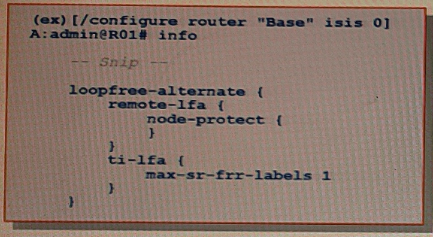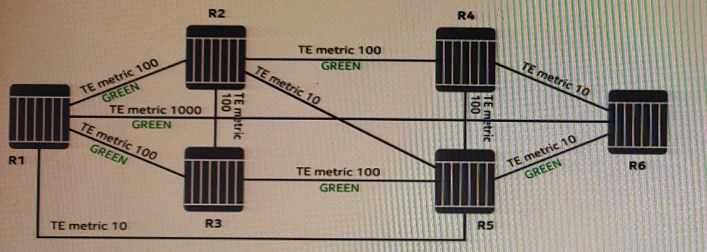Nokia Segment Routing 4A0-116 Exam Practice Test
Which of the following statements about a Segment Routing SID is FALSE?
Answer : B
A router advertises its local Node-SID as a local SRGB and an index only if it is configured as an index: This statement is not true, A router will advertise its local Node-SID as a local SRGB and an index, whether it is configured as an index or not.
The exhibit shows the fast re-route configuration on router R1, in which both R-LFA and TI-LFA have been enabled. Assume that there are multiple potential backup paths for a given prefix. Which of the following options will router R1 use?

Answer : D
The exhibit shows that both R-LFA and TI-LFA have been enabled on router R1. R-LFA (Remote Loop-Free Alternate) is a method that is used to protect the active segment of a tunnel, and it allows the router to find a backup path that coincides with the path that will become active after IGP reconvergence. TI-LFA (Topology Independent LFA) is a method that is used to protect an end-to-end multi-segment tunnel, it allows the router to find a backup path that does not rely on the IGP topology, but on the segment routing topology.
With R-LFA and TI-LFA enabled, router R1 will use a D-LFA (Dual-Loop-Free Alternate) path, which is a combination of both R-LFA and TI-LFA, this path will coincide with the path after IGP re-convergence.
A standard LFA, R-LFA, and D-LFA which do not coincide with the path after IGP re-convergence are not the options.
Based on the exhibit, which of the following statements about fast re-route for flex-algo instance 129 is TRUE?

Answer : C
Which of the following is NOT one of the main goals of traffic engineering?
Answer : D
Examine the exhibit.

An LSP is being configured to start at R1 and end at R6 using local CSPF. The LSP has the following constraints. Include admin-group GREEN, use the TE metric and hop-limit 3. What routers will be included in the LSP path?
Answer : C
Which of the following statements about enabling and using traffic engineering for Segment Routing is FALSE?
Answer : C
Bandwidth availability can be configured as a link attribute in SR-TE, it is used to control the amount of traffic that can be sent over a particular link.
Which of the following statements about Multi-Protocol Label Switching networks is FALSE?
Answer : D
The data is transparently carried from end to end: This statement is not true, MPLS does not provide data transparency, which means that the data is not carried unmodified from end to end. MPLS uses labels to forward data, so the original IP packets are encapsulated in new MPLS packets, and the original IP headers are not visible at the egress LSR.